The Copa America semi-finals are upon us with three South American powers not named Brazil, while Canada is Concacaf’s last hope. To kick it off, we pieced together a stats-saturated look at Argentina, Uruguay, Colombia and Canada.
There’s a reason Jesse Marsch followed Marcelo Bielsa as Leeds United’s manager: They both love to get to the end of the story. In football, moving with pace one way often begets pace back in the other direction, and they now find themselves on opposite sides of the Copa America semi-finals, coaching teams with very different football heritages.
Beyond that loose connection, it’s an interesting crew, these four remaining bosses of the Copa America semi-finalists. Uruguay’s Bielsa comes with sport-altering acclaim, but the Argentine could use a major tournament trophy to expand his case. Canada’s Marsch rose from the U.S. college game through MLS, and into Europe and its preeminent continental competition and domestic league.
Colombia coach Néstor Lorenzo, another of three Argentine managers among the group, had been a career assistant until 2021 when he took over at Peruvian club Melgar following seven years of deputy duties with the Colombian national team. Now 56 and two years into his return as the main man for Los Cafeteros, he’s never lost as Colombia attempt to extend their unbeaten run to a team-record 28 matches.
And then there’s Lionel Scaloni. The youngest of the four and arguably most accomplished, who came into the Argentina job as caretaker following a disappointing 2018 World Cup. The heavily criticised appointment nearly ended within a year after Argentina came up short of reaching the 2019 Copa America final. The 46-year-old is now on track for a third straight major tournament title, one of which added a star to the top of the Argentina crest.
The coaches had different paths to their jobs, and their teams have had different paths to this point in the competition. We chose a headline stat for each to help explain why they are here, what you may see this week, or how they might carry on to the final in Miami on 14 July.
Argentina: 37
Much has been made of the tempo of Bielsa’s Uruguay. The number of opposition passes they allow per defensive action (PPDA) is the lowest at the tournament (7.84), which equates to actively attempting to recover the ball.
Argentina, the most ball-dominant side at the tournament with the highest sequence time, most passes per sequence and most 10-plus passing sequences, aren’t far behind with a 7.97 PPDA. Only one side has actually turned high pressure into a goal at this tournament. That’s Argentina.
That probably shouldn’t come as a surprise. Argentina have more attacking tools than any of the other 15 teams to take part in this Copa America, and when you give them an opportunity to attack a defence in transition after winning it back, dangerous things tend to happen.
The goal came against their Tuesday semi-final opponents, Canada. The pair met in the tournament’s opening match, in which Argentina collected 10 high turnovers for their highest count of the tournament. Two of those ended in shots, including a questionable 87th-minute pass from the Canadian backline that was won back immediately by Argentina. It resulted in a 12-pass move and ultimately a Lautaro Martínez goal assisted by Lionel Messi.
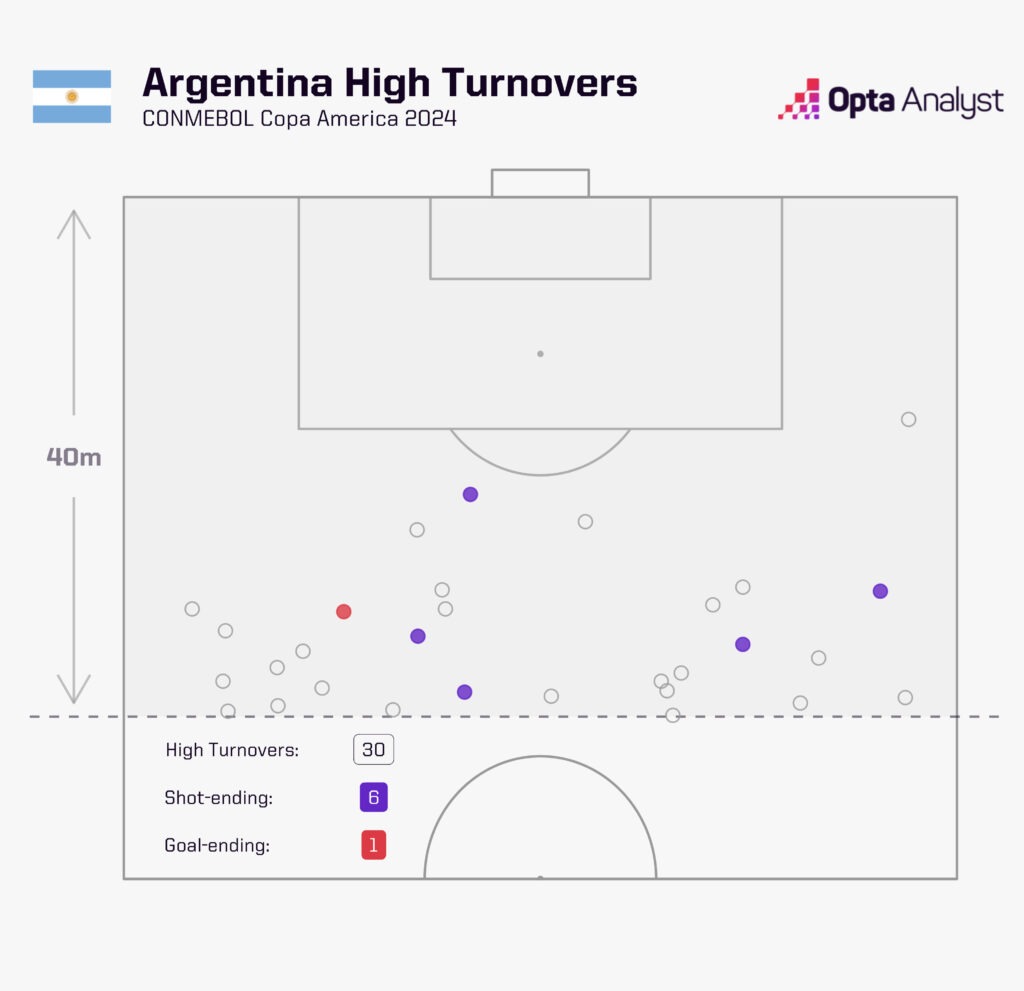
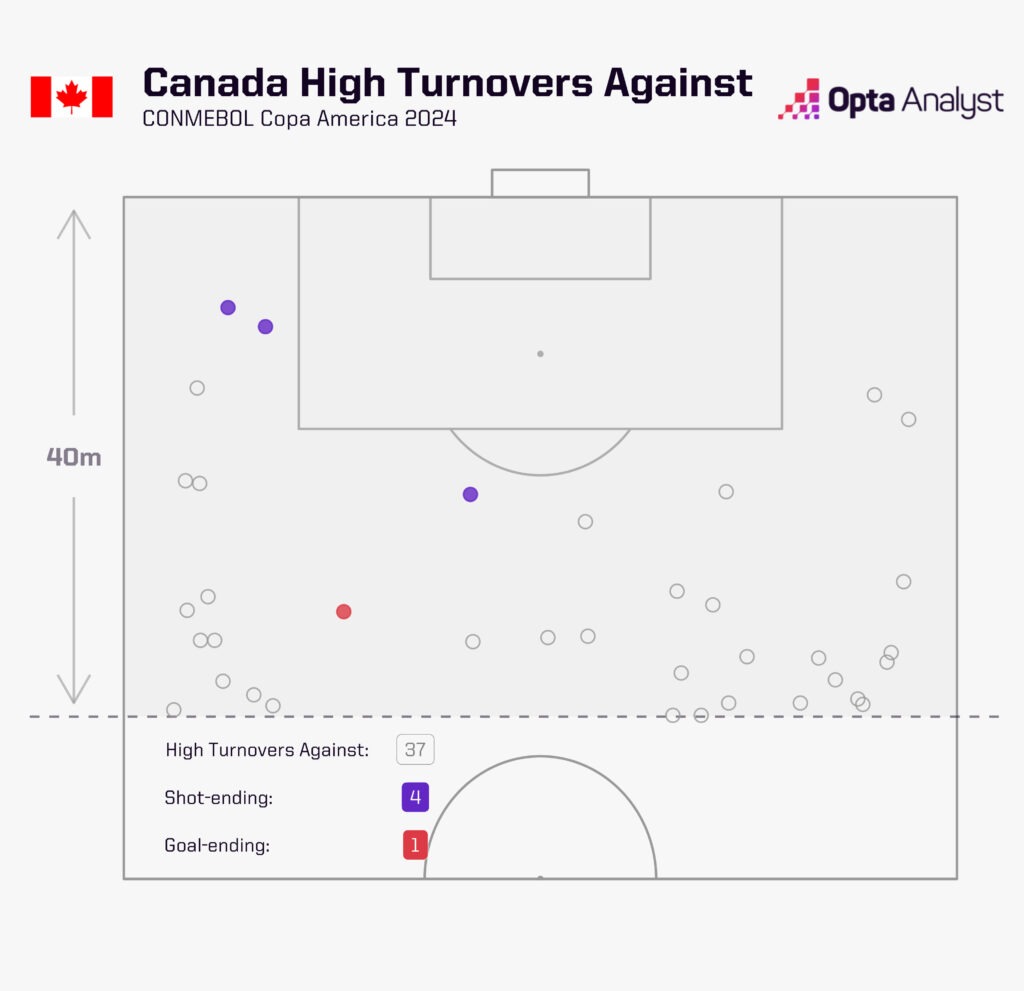
That’s not the only time Canada have been susceptible to a press. They issued at least seven high turnovers to each of their four opponents and account for three of the top 10 match totals (11 vs Venezuela, 10 vs Argentina, 9 vs Peru). Canada’s 37 high turnovers against are the most at the tournament. None of the other three semi-finalists are anywhere near that (Colombia are next highest with 25), and Canada’s four resulting in shots equal the combined number conceded by Uruguay (2), Colombia (1) and Argentina (1).
While there isn’t a pattern to decode on the locations of Argentina’s regains shown above, there’s more to see with where Canada might be open. All of the turnovers they’ve conceded leading to shots have been on the right half of the defence with two of those coming in advanced areas.
This also seems like a more realistic area for Argentina to press, given that Messi is more active on the other side of the pitch and hasn’t been 100%.
But pressing probably comes with some risks versus…
Canada: 40.2
Canada are going to get pinned back during stretches of their semi-final against Argentina. The average start distance of Canada’s sequences (40.2 metres) is third closest to their own goal at the tournament after Costa Rica and Jamaica. That figure’s not going to improve against La Albiceleste.
Successfully breaking the press and getting forward quickly with numbers may be where Jesse Marsch wants this team to eventually be, but does it suit Canada given their coach has been around for less than two months?
Well, there’s also the option of winning the ball back and getting out before any sort of pressure formulates. Canada, unsurprisingly, may be most effective against the top-ranked team in the world on the counter. That sounds obvious, but there’s also some tournament evidence to throw behind it.
There are players on this team who can run. Enter Jacob Shaffelburg, the workhorse winger of Nashville SC playing exceptional attacking football in this tournament. Canada have reached this point in the tournament by scoring just two goals. Shaffelburg has been involved in both with a goal and an assist.
His quarter-final goal against Venezuela developed on the right after a throw was fed to Jonathan David, who put a ball into the box for the streaking Shaffelburg. He had another chance that came down the right through Richie Lareya, who cut a pass back to Shaffelburg at the top of the box, which Shaffelburg controlled and forced a save from the keeper.
So he’s effective using his speed to break into the box without the ball, but Canada’s chances against Argentina seem like they could realistically come in transition. Those chances have come from the left.
Shaffelburg’s assist came against Peru in the 74th minute after a change of possession in Canada’s defensive third, an out ball from Cyle Larin to Shaffelburg in the attacking half, a quickly played ball across to David, who carried for a goal from the top of the box.
That should have been replicated against Venezuela in the 26th minute when Alphonso Davies played a ball to the same spot. Shaffelburg found David at the top of the box, but the Lille striker wasn’t able to hit the target:
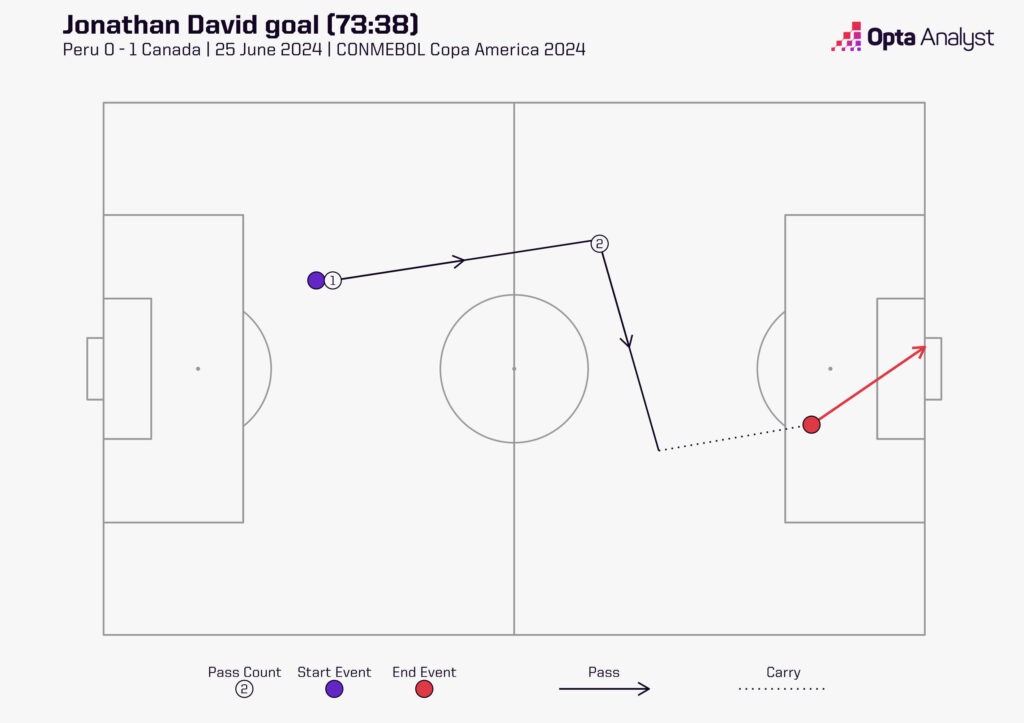
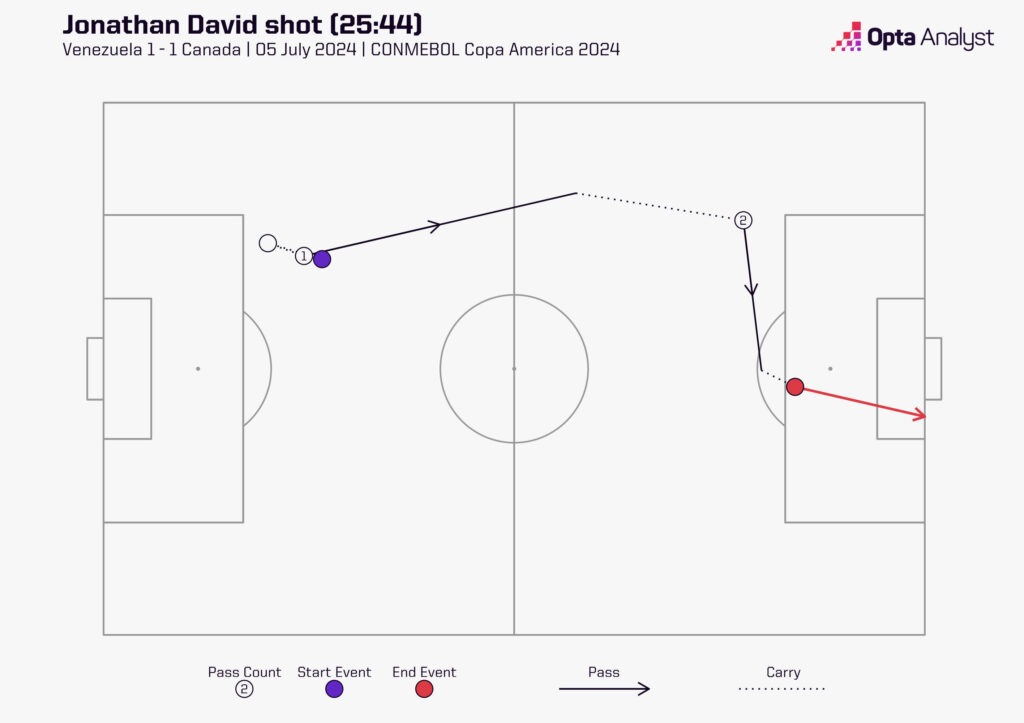
Shaffelburg forced himself into the starting XI after coming on as a substitute in Canada’s first two matches. He’s played just over an hour in the last two games, and if you’ve seen Canada play, you’ll understand why. The tank empties fast with his work ethic.
During the group stage, Canada favoured the right going forward. That shifted against Venezuela with much more coming up the left:
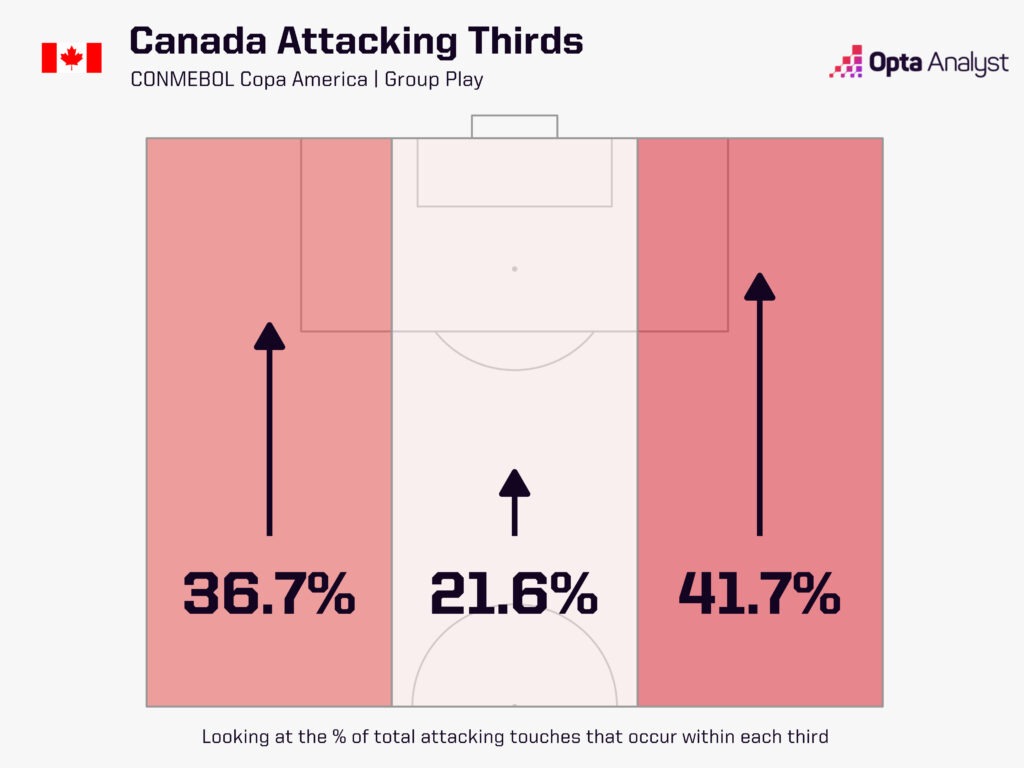
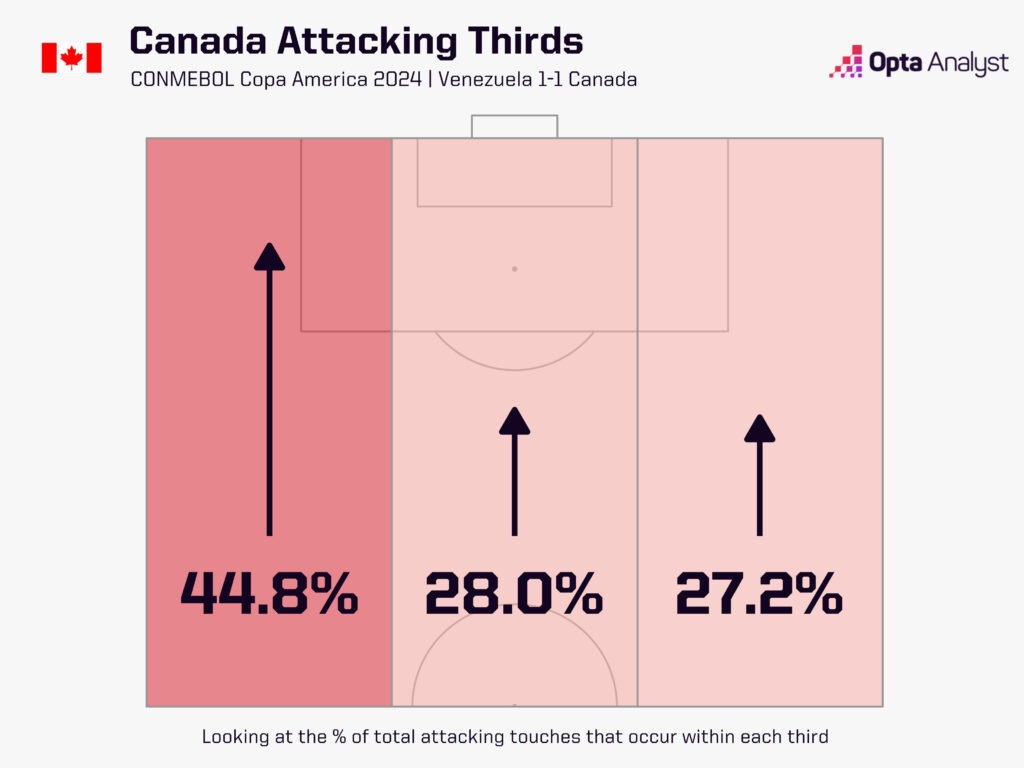
They still have a long way to go to match some of the production from the wings coming from…
Uruguay: 26%
Argentina lead the tournament with 62 sequences of 10 or more passes. No other team has managed 50, with Brazil second at 49.
Uruguay, who have played as many matches as anyone at the tournament, have 24. That’s four fewer than Bolivia and tied with Canada and Mexico for seventh. It’s more than Peru’s three, but it’s still a strikingly low number for a team considered second favourites to win this thing.
They have been a part of two ugly matches at this tournament, first against the United States. The second half had the lowest combined passing accuracy of any half of the tournament (70.3%).
And then there was the Brazil match, which everyone wanted to see and no one wants to remember. The 73.3% passing accuracy of the first half was the lowest in a first half at the tournament. La Celeste’s 79.0% passing accuracy is the lowest among the remaining teams and 10th overall at the Copa America.
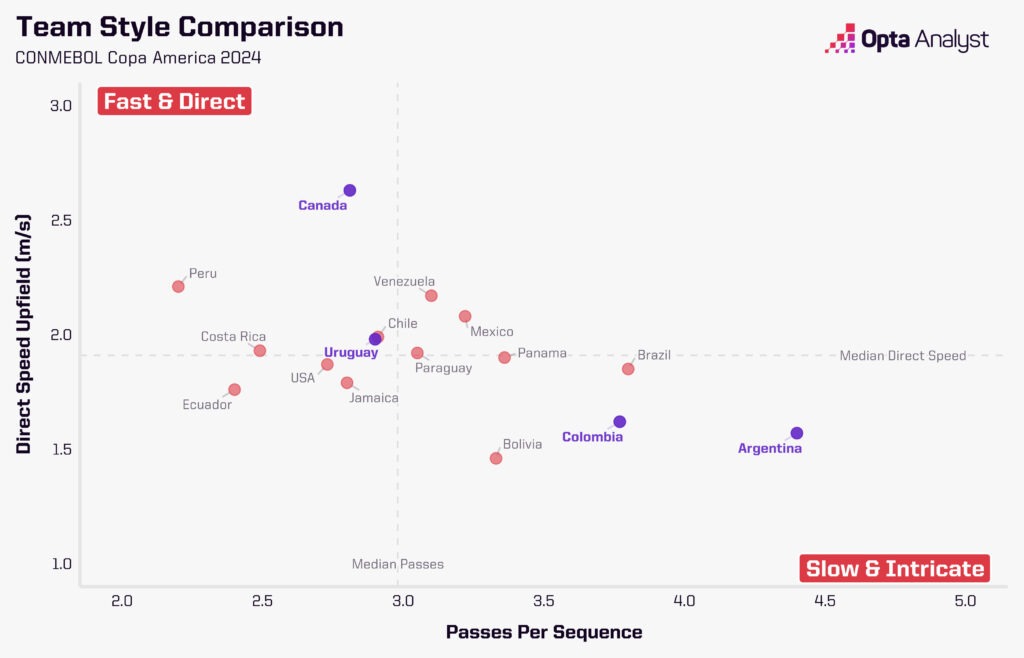
They looked great early in the group stage and have progressed regardless of aesthetics. So why are they, on paper, seemingly bad at passing, one of the fundamentals of football?
Perhaps because they don’t need 10 passes to get where they’re going, and perhaps because it’s more difficult to retain possession as one advances up the pitch. Passing numbers will always increase the deeper a team drops with the ball, and Bielsa has little interest in watching his defenders knock it around in the back. The man manages as if he has places to be and the pace of his team will somehow accelerate time.
Uruguay’s average starting distance is 44.2 metres from goal for the most advanced sequence starting average among the semi-finalists, which is impressive considering they played down a man from the 74th minute of their quarter-final against Brazil. Of all their passes at the tournament, 31.7% have ended in the final third. Canada are at 27.8%, while Colombia and Argentina are just under 20%. They also have a tournament-leading 31 line-breaking passes that have broken two opposition lines.
It follows that Uruguay are the only team at the tournament with more touches in the attacking third than the defensive third (26%):
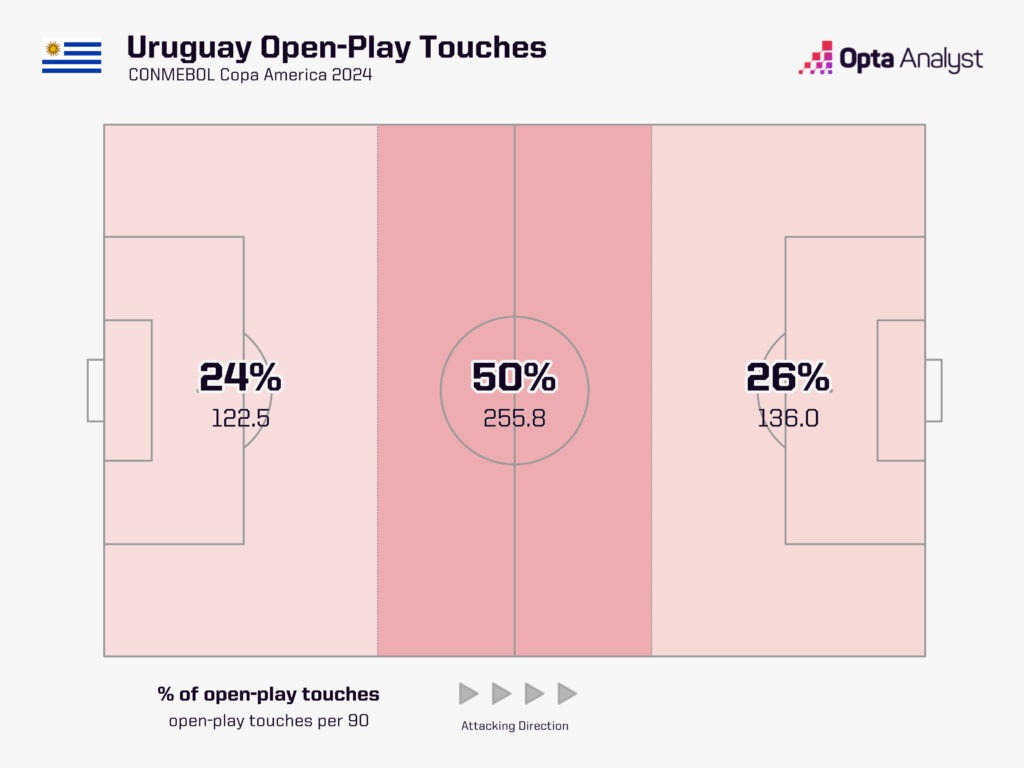
As we admire that visual homage to getting on with it, we’ll again state that they played down a man from the 74th minute against Brazil.
Bielsa wanting to get the ball forward is resulting in crosses. They’ve delivered 52 open-play crosses for a tournament-high 17 successful open-play crosses on a 32.7% accuracy. No other team at the tournament is over 20%, and the other three teams still alive combine for 22 successful open-play crosses. Volume, meet efficacy.
Their zones of control reflect this with more command of the attacking flanks than any team at the tournament:
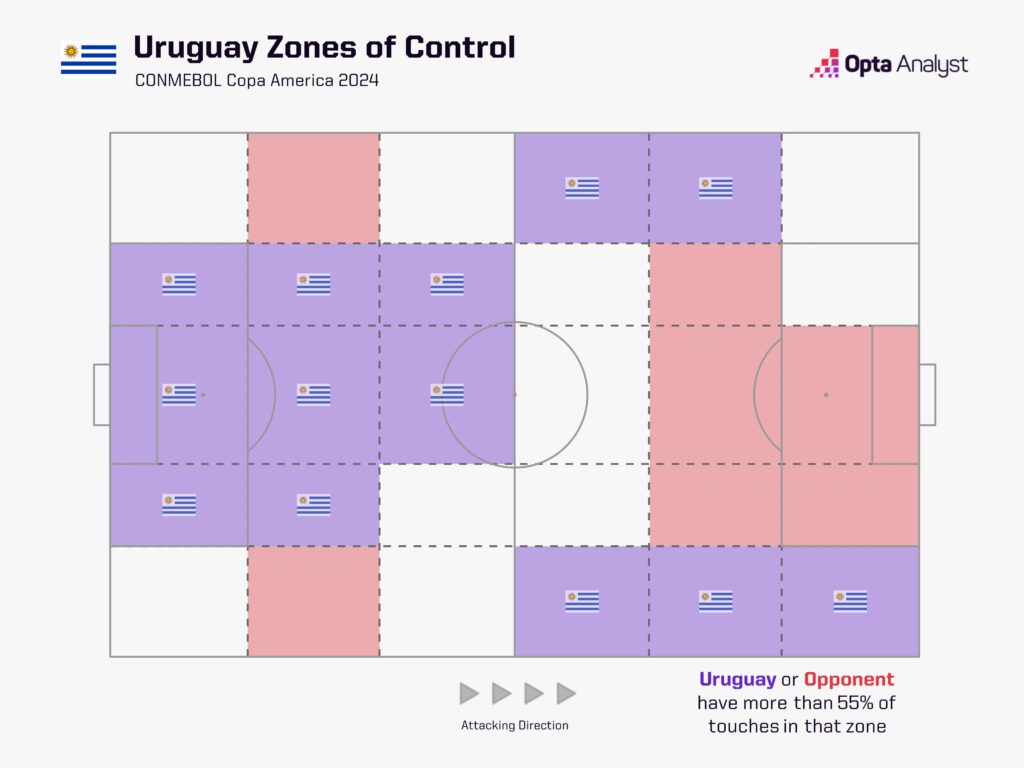
The key qualifier in much of that is open play. Bring set-pieces into the conversation, and you’ve got to look at…
Colombia: 2.4
Much has been made of James Rodríguez’s tournament, and for good reason. He leads the Copa America with six goal involvements (a goal and five assists), as well as chances created with 14. Ten of those, for better or worse, have come from set-pieces. Colombia have scored on four. Uruguay will absolutely be focusing on defending those on Wednesday, particularly with Ronald Araujo out for the tournament through injury.
But what about Colombia’s overall attacking production? Let’s talk our way through their attacking numbers.
Goals: 11. Leads tournament. Sounds great. Next.
Expected goals: 7.31. Second at the tournament to the title holders. Add another great to the list.
Non-penalty expected goals: 4.95. Last among semi-finalists and much more in the ballpark of Mexico (4.08) than Argentina (8.11). Not so great.
Open-play expected goals: 2.4. That’s half of what Canada have created from open play and lower than nine teams at the tournament, including two teams that didn’t reach the knockouts. Add another to the not-so-great list.
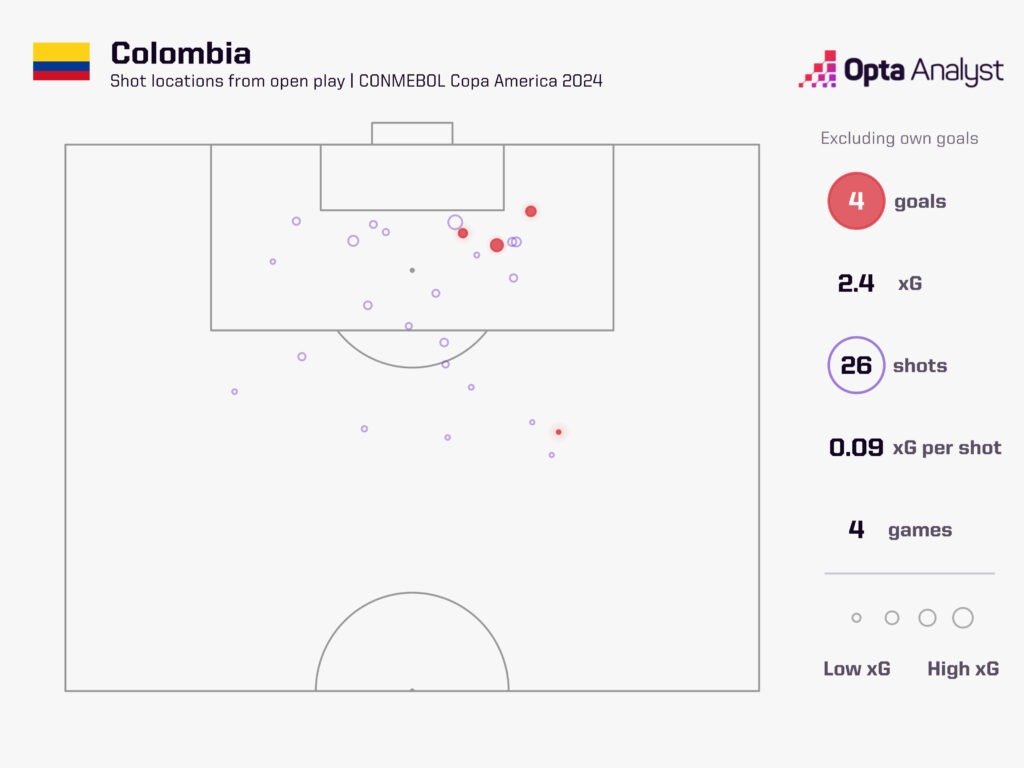
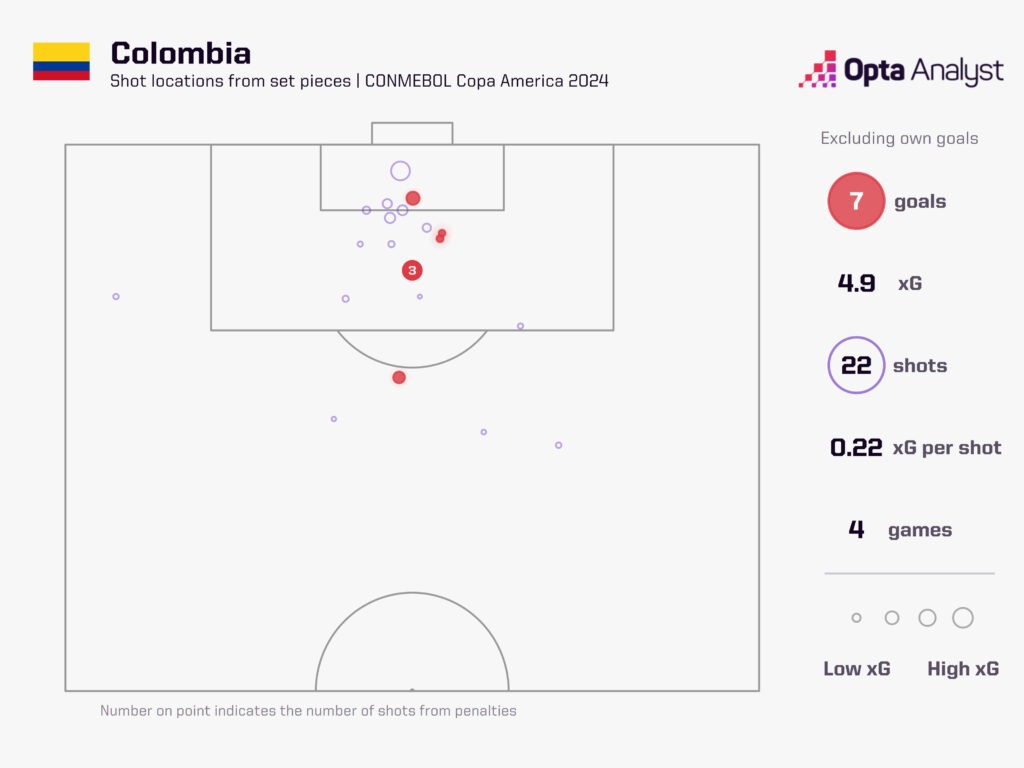
But let’s not discount just how good they have been on set-pieces. They have still scored eight non-penalty goals, which is second to Uruguay (9). It’s just that Uruguay have produced nearly two more non-penalty expected goals, so there’s an element of sustainability to consider.
Tempt the xG gods and you will eventually lose, but perhaps that’s the beauty of a six-game tournament. Maybe the underlying metrics don’t catch up with you until after the parade.
The flip of that is Colombia have allowed very little, with two goals conceded on 1.77 xG against for the second-lowest mark at the tournament regardless of how many games they’ve played. It’s just that the team ahead of them is still alive and happens to be their next opponent.
Enjoy this? Subscribe to our football newsletter to receive exclusive weekly content. You should also follow our social accounts over on X, Instagram, TikTok and Facebook.
